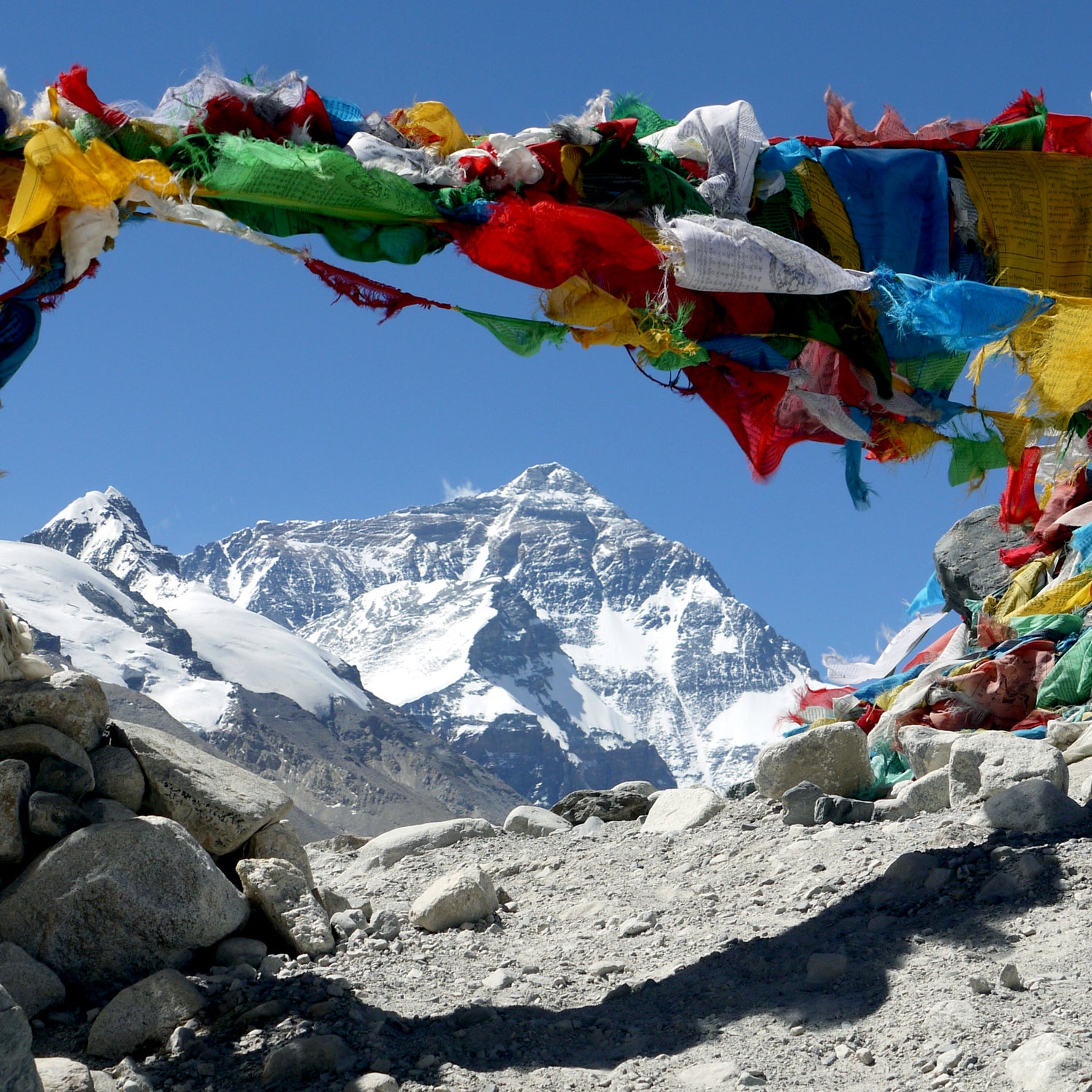In the wake of the April 18 avalanche that killed 16 Sherpas in the Khumbu Icefall, most South side Everest expeditions have packed up and left. But the Everest season is far from over. On the North side, in Tibet, nearly 80 clients and roughly the same number of Sherpa and guides are in the middle of acclimatizing. Climbers from the Tibet Mountaineering School are currently fixing ropes up to the North Col, and a meeting among guiding outfits about the final push to the summit is scheduled for May 10.
“Our expedition is still progressing, unaffected by the events of the South,” says Dave Pritt, director of the U.K. guiding company ���ϳԹ��� Peaks, which currently has .
In the media crush surrounding Everest, it often gets overlooked that there are actually two fixed routes to the summit available to paying clients. The South side, in Nepal, is far more popular. According to the Himalayan Database, which tracks climbs in the region, roughly two-thirds of the 6,871 successful Everest summits since 1953 have been from the South. But the North Col route, as it is known, has always attracted its share of mountaineers. George Mallory and Andrew “Sandy” Irvine were attempting the North Col when they disappeared high on the mountain in 1924. Because climbers can avoid the Khumbu Icefall, which has been responsible for an inordinate number of deaths on the mountain, the North Col is often considered the safer route, even though there’s more exposure higher up on the mountain.
For years, the North side was also cheaper, in large part because Chinese permits were less expensive and a road to base camp negated the need for spendy yak caravans. The reason fewer climbers and guiding companies go north has pretty much everything to do with politics: the base camp on the north is in the politically fraught region of Tibet, and climbing permits are under the control of the China Tibet Mountaineering Association (CTMA), an arm of the government that hands out and revokes them on a whim.
“There’s no rhyme or reason for granting or rejecting permits or the delay in permitting,” says Luis Benitez, owner of Endeavor Consulting and a six-time Everest summitter. “You’re at the mercy of the Chinese mountaineering authority, and they do what they want when they want.”
Benitez was at the center of what turned out to be a pivotal moment for understanding China’s schizophrenic nature when doling out permits. In 2006, he was guiding on Cho Oyu, the sixth-highest mountain in the world, when he saw Chinese soldiers shoot a 17-year-old nun as she attempted to flee over 19,000-foot Nangpa La Pass. Benitez, with an email connection in camp, fired off details about the death and the story went around the globe. Not long after, Chinese soldiers confiscated his sat phone, as well as phones of others at the camp. For the Chinese, who view the Dalai Lama as a terrorist and Tibet as an insurgent province, the bad press served as a wake-up call.
“The Chinese saw that they needed to control things better,” says Benitez. “They built a larger garrison nearby, so now there’s more roving patrols in the valley, and the level of control is very different now from in 2006.”
In 2008, the situation was further complicated when the Chinese insisted on bringing the Olympic torch relay over the highest point in the world. Many expeditions had set up at base camp on the North, and climbers were flying in from around the world when word came down that they couldn’t continue until the torch relay proved a success.
“I was all ready to go,” says Everest summitter Alan Arnette, who covers Himalayan expeditions on his popular blog alanarnette.com. “I was ready to fly out to Kathmandu, and five days before leaving we were informed by the CTMA that we couldn’t travel to Base Camp until late April or early May, which logistically made it impossible to acclimatize, get the ropes set, and summit before the monsoons.”
Many of the expeditions in 2008 had already set up on the North side, including the largest at that time, Himalayan Experience (Himex). Most quickly packed up and left for the South, many permanently. The North Col route only saw 39 summits in 2008, compared with 373 the year before. Since the torch relay, the North Col has seen far fewer people top out than via the South Col. In 2013, there were 177 successful summits from the North and 539 from the South.
This year, there are at least 10 expeditions on the North side, with the largest being the 7 Summits Club, a Russian-led team that has 19 climbers. In many ways, both sides of the mountain are the same: the majority of teams are large groups with clients paying tens of thousands of dollars.
“Commercial climbing has evolved to become completely reliant on a western-level business infrastructure,” says Benitez, “and western-level business infrastructure doesn’t always work in some of these other countries.”
That’s more apparent now than ever. After the South side was effectively closed last week, despite a last-ditch effort from the government of Nepal to save the season, some outfits expressed interest in heading to the North. But that prospect seems extremely unlikely, given both the uncertainty over obtaining permits and the logistics of transitioning to the other side. When HimEx switched over to the South in 2008, the cost of moving gear was estimated by Kari Kobler, co-owner of Kobler & Partner—a Swiss outfit that currently has 11 clients and 14 Sherpa on the North side—at $400,000. The expense pretty much ends discussion about the possibility of entire outfits jumping to the North this year. But there may be a few wealthy, extremely committed individuals who can pay their way onto a North side expedition that has already set up shop in base camp.
“I’m positive there are people trying,” says Arnette, “but the odds of success are really low. You’d need to get a climbing permit, entry visa, and then make the road journey up to base camp.” Normally that would take a week, but most of the climbers in Kathmandu trying to finagle a permit have already spent a couple of weeks at 17,500 feet, so they could conceivably drive straight there. That would still take a solid three days, plus a border crossing in China. “Also, they’d have to have tents, oxygen, food, and other supplies that could be brought over with them,” says Arnette. “Logistically it would be a moon shot.”
As for whether it makes more sense to head to the north in future years, that’s still uncertain. With China a wildcard when it comes to obtaining permits, it would be hard to envision a commercial outfitter risk booking clients for $60,000 or more, only to have an expedition fall through at the last minute. Many climbers have speculated that China has also become more difficult to deal with for Americans after President Obama hosted the Dalai Lama at the White House in February.
Robbie Barnett, the director of modern Tibetan studies at Columbia University, says it’s not uncommon for Chinese officials to strike back in this manner, pointing to a Norwegian travel ban in Tibet after the Nobel Prize was awarded to the Chinese writer and political commentator Liu Xiaobo in 2010. “Usually these bans apply to tourist visas, but that could easily include mountaineers,” says Barnett. “They last a few months or even a couple of years. It’s a very erratic process, rarely if ever acknowledged in print by the Chinese.”
The Chinese are also, no doubt, still wary of foreigners in Tibet.
“I think the random permitting is directly tied to climbers having access to satellite phones and the ability to communicate in places where human rights problems are an issue,” says Benitez, who had a traverse permit pulled by the Chinese authorities in 2005 when he was halfway up the mountain.
Operating in Tibet is further complicated by logistics. Most organizations still hire Sherpas in Nepal as supporting guides for their trips in Tibet, even though the CTMA is ostensibly responsible for fixing lines to the summit (a consortium of guides from various expeditions helps ensure the ropes are installed on time). For each Sherpa, China now charges $3,000 for a work visa, adding to each company’s overall cost.
Ultimately, the future is still hazy. Over the weekend, the Nepal government allowed helicopter flights to Camp II on the South side, so that Sherpas could batten down the camp and leave it there for the winter, an unprecedented move. Discussions are also heating up again about whether to allow helicopters to ferry gear up to Camp II during the climbing season, so that climbing Sherpas don’t have to make as many rotations through the Icefall.
“Ultimately, what happened will completely change the face of climbing on the South side,” says Benitez. “I really hope that’s for the good, for the betterment of the Sherpas and the betterment of climbing in general.”
But companies with millions of dollars on the line may need to wait and see if that holds true.
“People don’t like instability and uncertainty, and it’s uncertain on both sides,” says Arnette. “As if climbing the mountain wasn’t difficult and uncertain enough, now you don’t even know if you’ll get the chance.”


